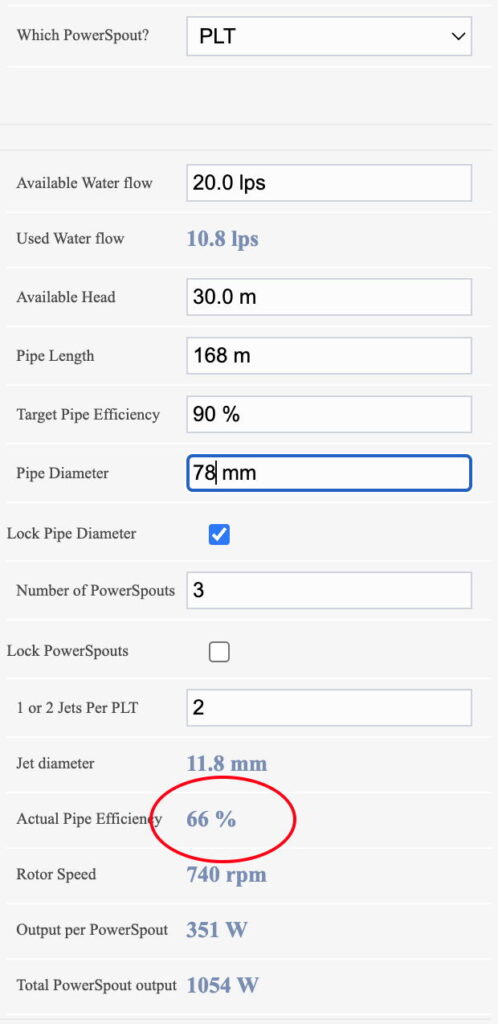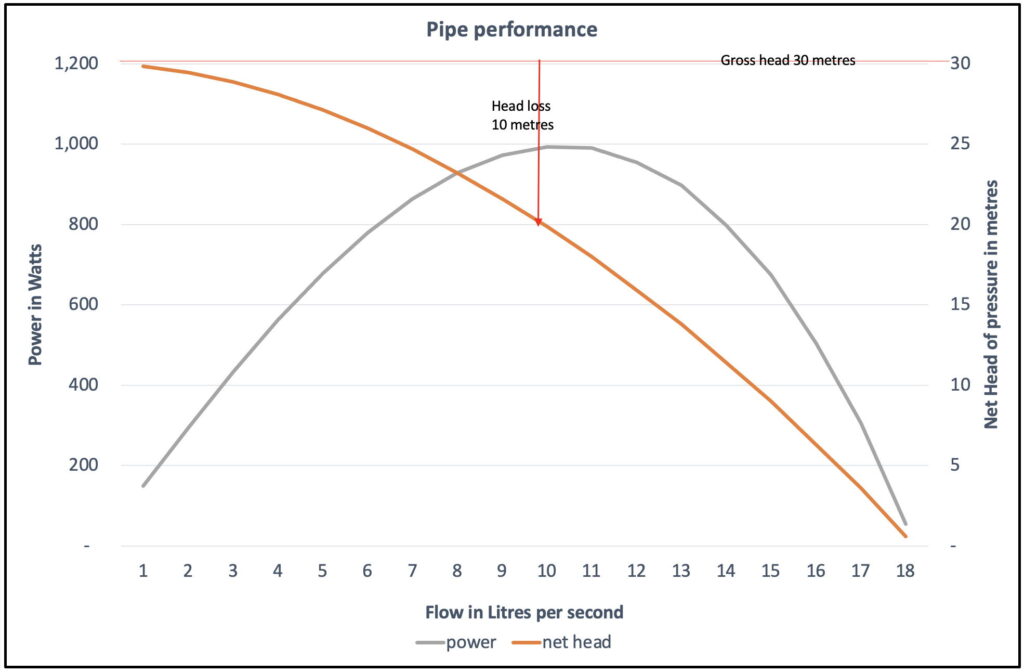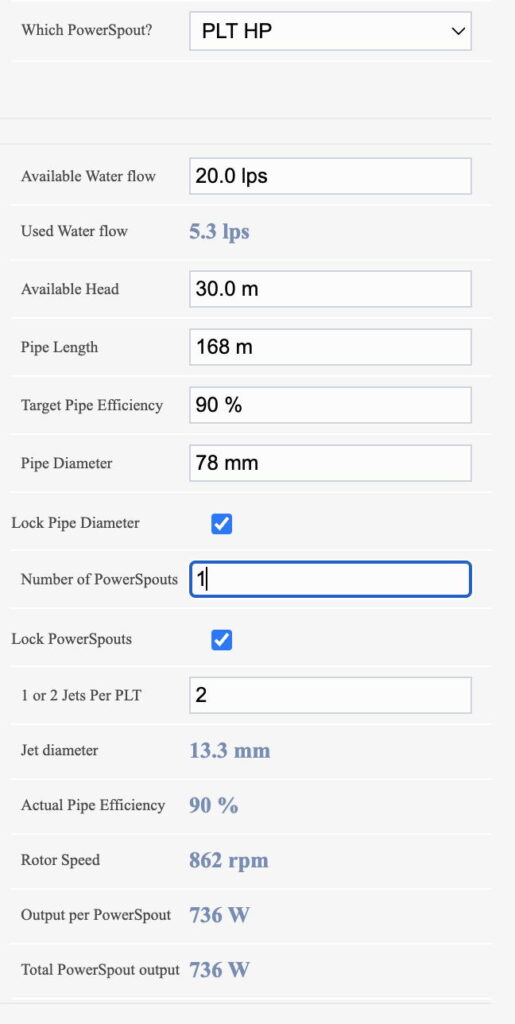I spend a lot of my time doing “what if” scenarios for people who want a hydro turbine. I use the Powerspout online calculation tool to get me quick answers. I can edit the numbers, and the screen will update with new results after a few seconds. Very useful , once you get the hang of how it works. As with most things, it helps to read the manual, but you can also just dive in and play with it.
First I enter the basic numbers: the head and the flow and the pipe length. The tool suggests a pipe diameter to carry the flow while only losing 10% of the static pressure in pipe friction. (Target=90% efficiency) Let’s take an example:
 Flow 20 litres per second
Flow 20 litres per second
Head 30 metres
Pipe length 168 metres
The calculator tells us we need 127mm pipe. This is the internal size of the pipe, meaning that the outer diameter will be about 140mm, an unusual size to buy and very costly so we try entering a size of our own.
 We have access to some cheap surplus 90mm pipe with internal size 78mm so we enter this in the calculator. See what happens (second screenshot on right).
We have access to some cheap surplus 90mm pipe with internal size 78mm so we enter this in the calculator. See what happens (second screenshot on right).
The “Used flow” is now only 10.8 lps.
The “Actual pipe efficiency” is 66%.
This is a key number for pipe performance. It means that you only have 2/3 of the pressure remaining at the turbine, after friction loss in the pipe. And the power output is impacted by this pressure drop. If you open up more jets, or fit larger jets in the turbines, you will increase the flow used but you will get even more pressure drop.
The special thing about 66% efficiency is that this is the point where the loss of pressure happens faster than the increase in flow so you will actually get less power if you use more than this amount of water. The calculator will not go beyond this point. This is the “sweet spot” where you get maximum power. The pipe can carry 18 litres per second (wide open – no turbine) but by that time there will be no pressure left at all and the water will flow out without producing any useful power.

This chart shows how the power (grey curve) changes as the flow increases (left to right) and the pressure drops (red curve). Power is proportional to flow multiplied by pressure. At first the power increases steeply with flow rising, but power also depends on the pressure, so the rapid plunge in pressure also affects it. Power peaks at 10.8 lps, after which it’s all downhill.
It seems a no brainer to go for this peak power, and this may be a good idea in some cases, but often it’s worth thinking about the big picture. For one thing, there is a tendency for pipes to get fouled over time and become less efficient, so in a few years this may no longer give the same result, whereas the impact is much less where the head loss is modest. Second, you are not making very good use of the water. If you really have this much water all the time then think seriously about using a larger pipe (or even two small ones if they are cheap enough to get). If you don’t have this much flow very often then perhaps a smaller scheme using fewer turbines will be more cost-effective and will work with less management. Bear in mind that it can become a burden to open and close valves every time the weather changes.
In the above “maxed out” example the calculator chose 3 standard PLT turbines.
Changing the “turbine type” to TRG HP we could handle all of this flow with one turbine. (Try it and see. I have not done a screen shot for this.) And the calculator would indicate better power production, 1160W output. A note of warning though. The PLT turbines output figures tend to be understated by the online tool, whereas the TRG figures it gives you are the highest you could hope to see. In reality the PLT is a quieter, more efficient turbine that I would recommend using where possible.
If the pipe is to be 90mm HDPE (with 78mm internal) then my preferred option would be one PLT HP turbine. Enter PLT HP at the top and enter 1 for “number of turbines”. Output is stated as 736W but will likely reach at least 800W in reality using only half the flow of the previous example. This scheme will be much more efficient and will work better as the weather gets drier. It will not be affected much by fouling of the pipe as the pipe loss is only 10%. I would probably choose the single PLT HP rather than the TRG. But I there is a case for the TRG if the flow is rarely less than 11 lps and you are ready for a decline in output over time.
Often it depends on the relative cost. If the pipe is very long then it will become a major cost in the project versus the turbines etc so the temptation is to max it out by using the flow that gives the most possible power. If the pipe is shorter, then there are several good reasons to use a large enough pipe to achieve 90% efficiency.


Hi Hugh,
I have a mill with a leat approx 1000m long and a head of approximately 10 meters from the weir.
Lots of water though.
It was in a trench but I would like to put it in a pipe so that I can use the full pressure and eliminate leakage.
Cold you give me any idea of the pipe diameter that might be preferable and some sort of idea of the power that might be available in each pipe diameter. It used to run two overshot wheels of 4m diameter. I would be grateful for any assistance that you might be able to give. Thank you.
1000m is a long way to go for 10m drop. You can use the calculator on the Powerspout site to find the answer. Using 150mm bore pipe (160mm soil pipe for example) you can get over 400W power with a powerspout TRG.